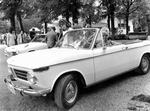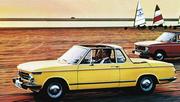BMW 2002 Story
With BMW’s new compact 1-series about to go on sale, Andrew Noakes looks back at the small saloon that saved the company – the ’02 series
Maybe it’s hard to believe, but BMW – makers of some of the world’s most respected cars and motorcycles, builders of some of Formula 1’s most powerful engines, a driving force in the German motor industry – stood on the very brink of bankruptcy only a generation ago.
The first post-war car from BMW was the 501, a large and heavy saloon with old fashioned styling that earned the car the nickname of ‘Baroque Angel’, a reference to the old carved figures in German churches. Initially they had straight-six power and later a V8, which would also go into the strikingly pretty 507 roadster which was BMW’s attempt to muscle in on Mercedes-Benz 300SL territory.
Bubbles
These were all costly cars though and in a bizarre effort to add volume sales BMW also built its own version of the Isetta bubble car under licence, fitting its own four-stroke motorcycle engines.
BMW’s Isetta sold well for a while, but the bubble car craze soon ended and buyers wanted proper small cars like the VW Beetle. Unable to compete with the Beetle on price, BMW rapidly ran out of money, and by 1959 the company was in crisis.
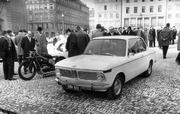 The saviours were industrialists Harald and Herbert Quandt who injected fresh capital into the moribund firm and instigated development of a new mid-range four-door car, known as the Neue Klasse or ‘New Class’. That reached production as the BMW 1500 saloon in 1962, and by 1964 a quicker 1600 had replaced it and an even more powerful 1800TI had been added to the range. A 2.0-litre engine was dropped into the four-door shell in 1966, the year BMW celebrated its 50th anniversary. Between them these Neue Klasse cars saved BMW’s bacon, well over 100,000 of them being built during the 1960s.
The saviours were industrialists Harald and Herbert Quandt who injected fresh capital into the moribund firm and instigated development of a new mid-range four-door car, known as the Neue Klasse or ‘New Class’. That reached production as the BMW 1500 saloon in 1962, and by 1964 a quicker 1600 had replaced it and an even more powerful 1800TI had been added to the range. A 2.0-litre engine was dropped into the four-door shell in 1966, the year BMW celebrated its 50th anniversary. Between them these Neue Klasse cars saved BMW’s bacon, well over 100,000 of them being built during the 1960s.
...into the 70's
A sportier two-door version also appeared in 1966, powered by the 1600 engine and called the 1600-2. With its shorter wheelbase and lighter bodywork it was all but as fast as the four-door 1800 and handled better. As the 1970s dawned the four-door car was replaced by the new 5-series but the two-door – now renamed the 1602 – continued as BMW’s entry-level model. Independent suspension – MacPherson struts at the front, coil-sprung semi-trailing arms at the rear – gave it tidy handling for its time, and in twin-carb, 105bhp 1602ti form it was a natural rival to sports saloons from Alfa Romeo and Lancia. What it needed was more power.
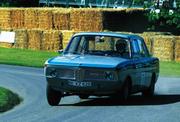
|
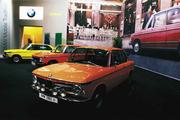
|
2 litres
Pressure from BMW’s US importer Max Hoffman for a swifter ’02 model helped: the twin-carb 1600 engine couldn’t pass American emissions regulations but the 2.0-litre could. The 2002, with the 2.0-litre engine from the four-door 2000 saloon in the shorter shell of the 1602, was announced in 1968 and quickly proved its potential by winning the European Touring Car Championship in the hands of Dieter Quester. A twin-carb 2.0-litre road car, the 2002ti, soon followed.
A cabriolet had been introduced in 1967, and in 1971 it was replaced by a Targa-top car with a fixed roll hoop behind the front seats. 1971 also saw the introducing of another derivative, the Touring, a three-door version of the ’02 that offered an early taste of hot hatchback motoring.
Meanwhile the quest for more power continued. The twin-carb 2002ti had never made it to the UK or US, and the Brits and Americans had to wait for an even more powerful 2002, the 'tii' of 1971. Fitted with Kugelfischer mechanical fuel injection, the two-litre in-line four delivered a smooth and economical 125bhp which cut the 2002’s 0-60mph time from more than 10 seconds in single-carb guise to the mid 8s.
260bhp+
 For racing BMW had already developed a pair of 16-valve racing engines based on the 2002 unit. The first, developed by Ludwig Apfelbeck, had radially positioned valves and 16 individual ports, and developed around 260bhp. The second, which debuted in 1967, rearranged the valves but again had 16 ports. Finally, in 1972, BMW introduced a more conventional cross-flow 16-valve head and in this form the engine produced up to 275bhp and powered March’s Formula 2 cars. BMW tuning firm Schnitzer, meanwhile, produced its own 16-valve head which could be fitted to a production block and ran in the company’s own racing 2002s.
For racing BMW had already developed a pair of 16-valve racing engines based on the 2002 unit. The first, developed by Ludwig Apfelbeck, had radially positioned valves and 16 individual ports, and developed around 260bhp. The second, which debuted in 1967, rearranged the valves but again had 16 ports. Finally, in 1972, BMW introduced a more conventional cross-flow 16-valve head and in this form the engine produced up to 275bhp and powered March’s Formula 2 cars. BMW tuning firm Schnitzer, meanwhile, produced its own 16-valve head which could be fitted to a production block and ran in the company’s own racing 2002s.
Another development, which went into BMW’s works 2002s for the 1969 season, was a turbocharged version of the ubiquitous four-cylinder engine. Turbo technology was still in its early days, at least as far as cars were concerned, but BMW made the system work and Dieter Quester benefited, taking another European Touring Car Championship title in the turbo 2002.
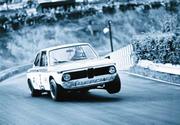 A production version of the turbo car followed in 1973, its KKK turbo blowing through the tii’s Kugelfischer injection and generated 170bhp. In the light 2002 body that meant colossal performance, at least in the top third of the rev range: the turbo didn’t make its presence felt until the crank was spinning at well over 4000rpm, and drivers had to contend with massive turbo lag thanks to the long intake tract and the high inertia of the turbine. Given the peaky delivery, driving the turbo fast on give-and-take roads was challenging, to say the least.
A production version of the turbo car followed in 1973, its KKK turbo blowing through the tii’s Kugelfischer injection and generated 170bhp. In the light 2002 body that meant colossal performance, at least in the top third of the rev range: the turbo didn’t make its presence felt until the crank was spinning at well over 4000rpm, and drivers had to contend with massive turbo lag thanks to the long intake tract and the high inertia of the turbine. Given the peaky delivery, driving the turbo fast on give-and-take roads was challenging, to say the least.
Public Outcry
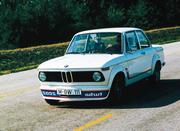
|
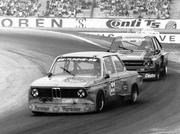
|
As a compromise the decal was removed, but another blow was about to hit the Turbo: the Yom Kippur war and the oil crisis of 1973/74, which sent fuel prices spiralling and killed demand for fast, thirsty cars overnight. Just 1672 Turbos were built, all left-hand drive, and only a handful still remain in Britain.
The 3-series took over in 1975 and, now that the 3-series has grown up through its several generations, we have the 1-series to form the next generation of compact BMWs. But we’d have none of these, and possibly no BMWs at all, had it not been for the 2002.
Links
Copyright © Andrew Noakes 2004
Gassing Station | BMW General | Top of Page | What's New | My Stuff

